Organisational Behaviour Report: Impact of Culture and Power Analysis
VerifiedAdded on 2020/11/23
|13
|3616
|320
Report
AI Summary
This report provides a comprehensive analysis of organisational behaviour, examining the interplay of culture, power, and motivation within a business environment. It begins by exploring the impact of culture and power dynamics on individual behaviour, differentiating between positive and negative influences and their effects on workplace productivity and employee engagement. The report then delves into motivational theories, evaluating both content theories (like Maslow's hierarchy and Herzberg's two-factor theory) and process theories (such as Vroom's expectancy theory), highlighting their role in understanding and enhancing employee motivation. Furthermore, the report discusses what constitutes effective and ineffective teams, and the concepts and philosophies of OB within an organisational context. It emphasizes the importance of clear policies, communication, and ethical considerations, concluding with recommendations for fostering a positive and productive work environment. The report also highlights the significance of understanding employee needs, creating a supportive culture, and leveraging both intrinsic and extrinsic motivation to achieve organisational goals.
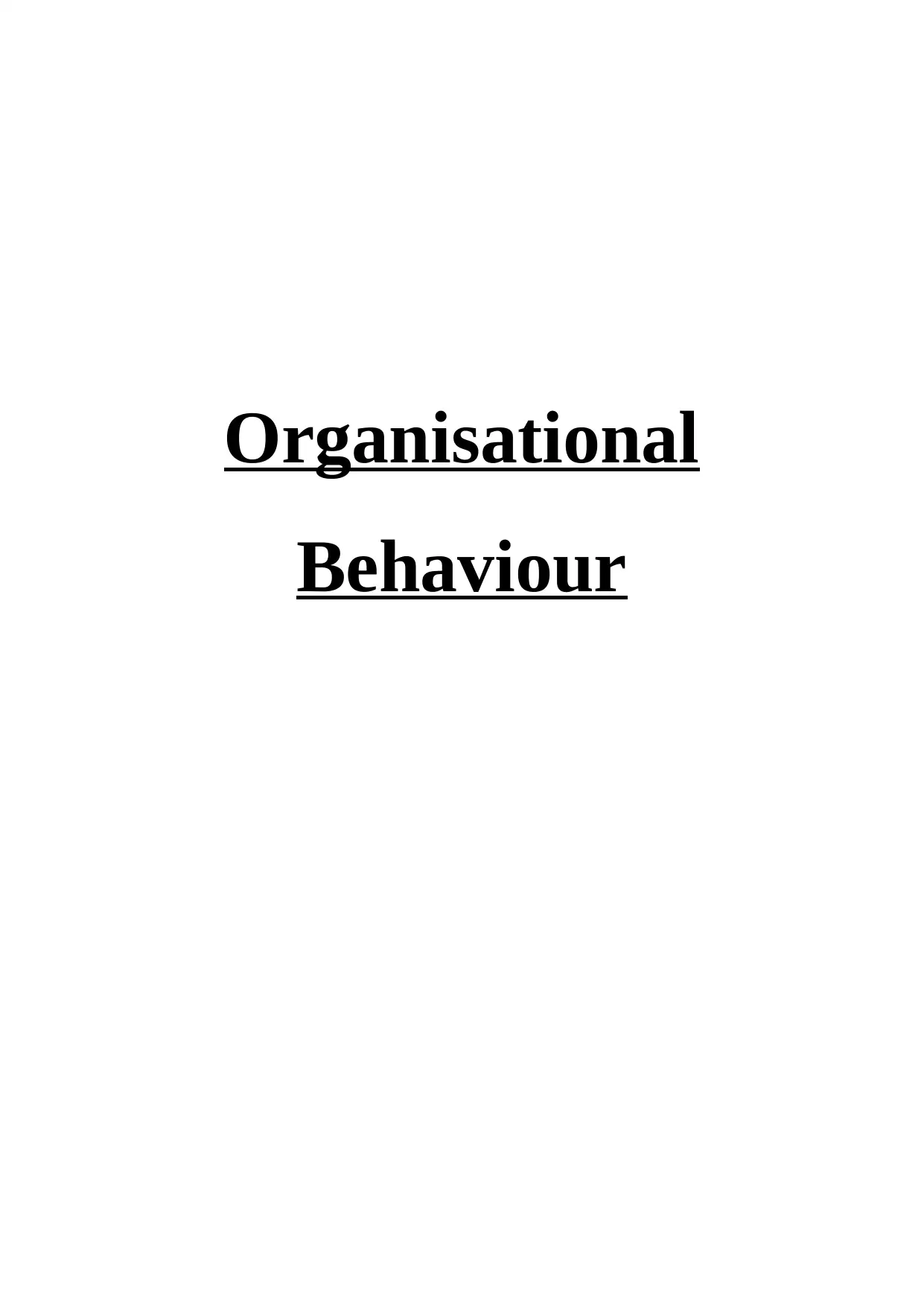
Organisational
Behaviour
Behaviour
Paraphrase This Document
Need a fresh take? Get an instant paraphrase of this document with our AI Paraphraser
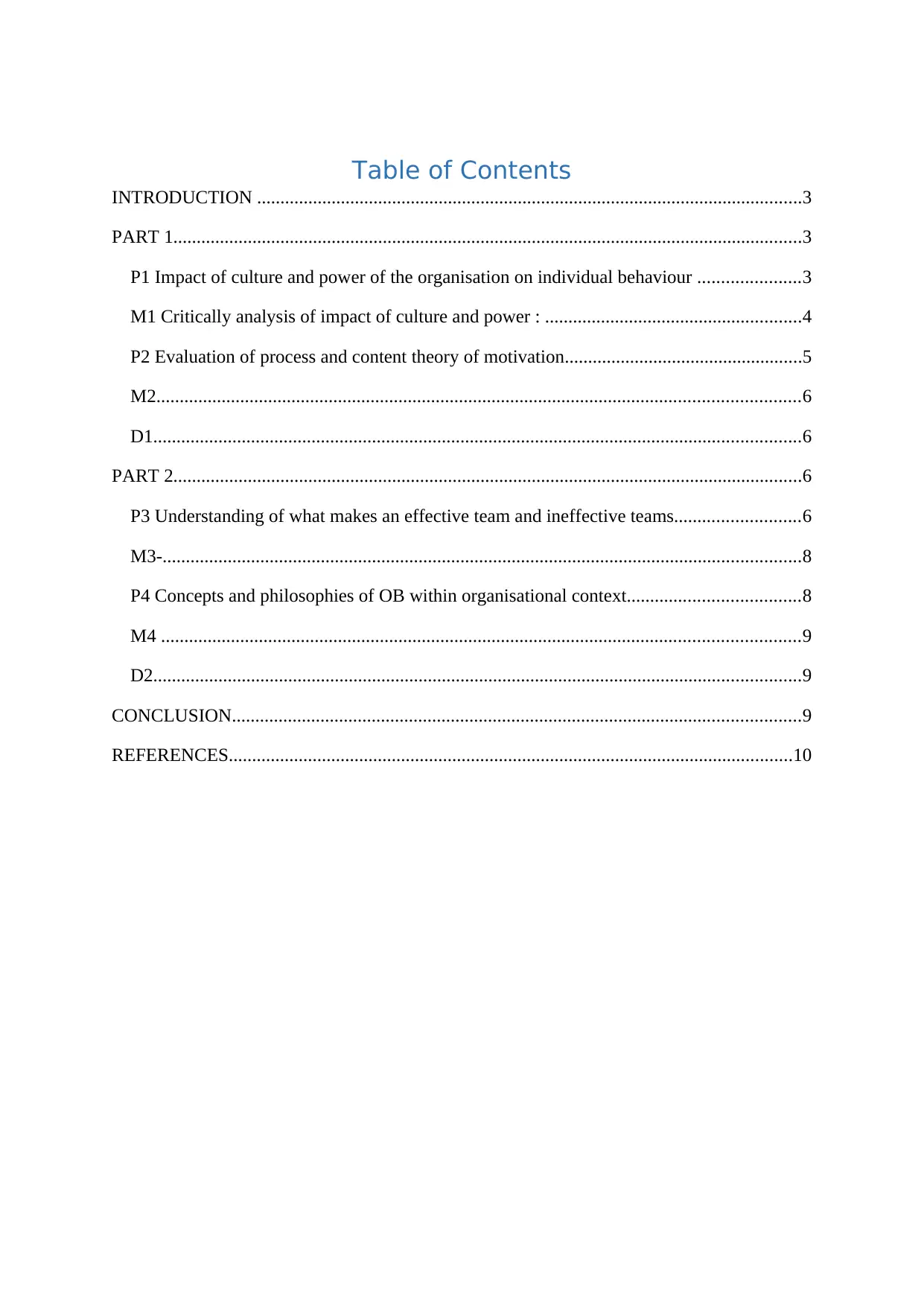
Table of Contents
INTRODUCTION .....................................................................................................................3
PART 1.......................................................................................................................................3
P1 Impact of culture and power of the organisation on individual behaviour ......................3
M1 Critically analysis of impact of culture and power : .......................................................4
P2 Evaluation of process and content theory of motivation...................................................5
M2..........................................................................................................................................6
D1...........................................................................................................................................6
PART 2.......................................................................................................................................6
P3 Understanding of what makes an effective team and ineffective teams...........................6
M3-.........................................................................................................................................8
P4 Concepts and philosophies of OB within organisational context.....................................8
M4 .........................................................................................................................................9
D2...........................................................................................................................................9
CONCLUSION..........................................................................................................................9
REFERENCES.........................................................................................................................10
INTRODUCTION .....................................................................................................................3
PART 1.......................................................................................................................................3
P1 Impact of culture and power of the organisation on individual behaviour ......................3
M1 Critically analysis of impact of culture and power : .......................................................4
P2 Evaluation of process and content theory of motivation...................................................5
M2..........................................................................................................................................6
D1...........................................................................................................................................6
PART 2.......................................................................................................................................6
P3 Understanding of what makes an effective team and ineffective teams...........................6
M3-.........................................................................................................................................8
P4 Concepts and philosophies of OB within organisational context.....................................8
M4 .........................................................................................................................................9
D2...........................................................................................................................................9
CONCLUSION..........................................................................................................................9
REFERENCES.........................................................................................................................10
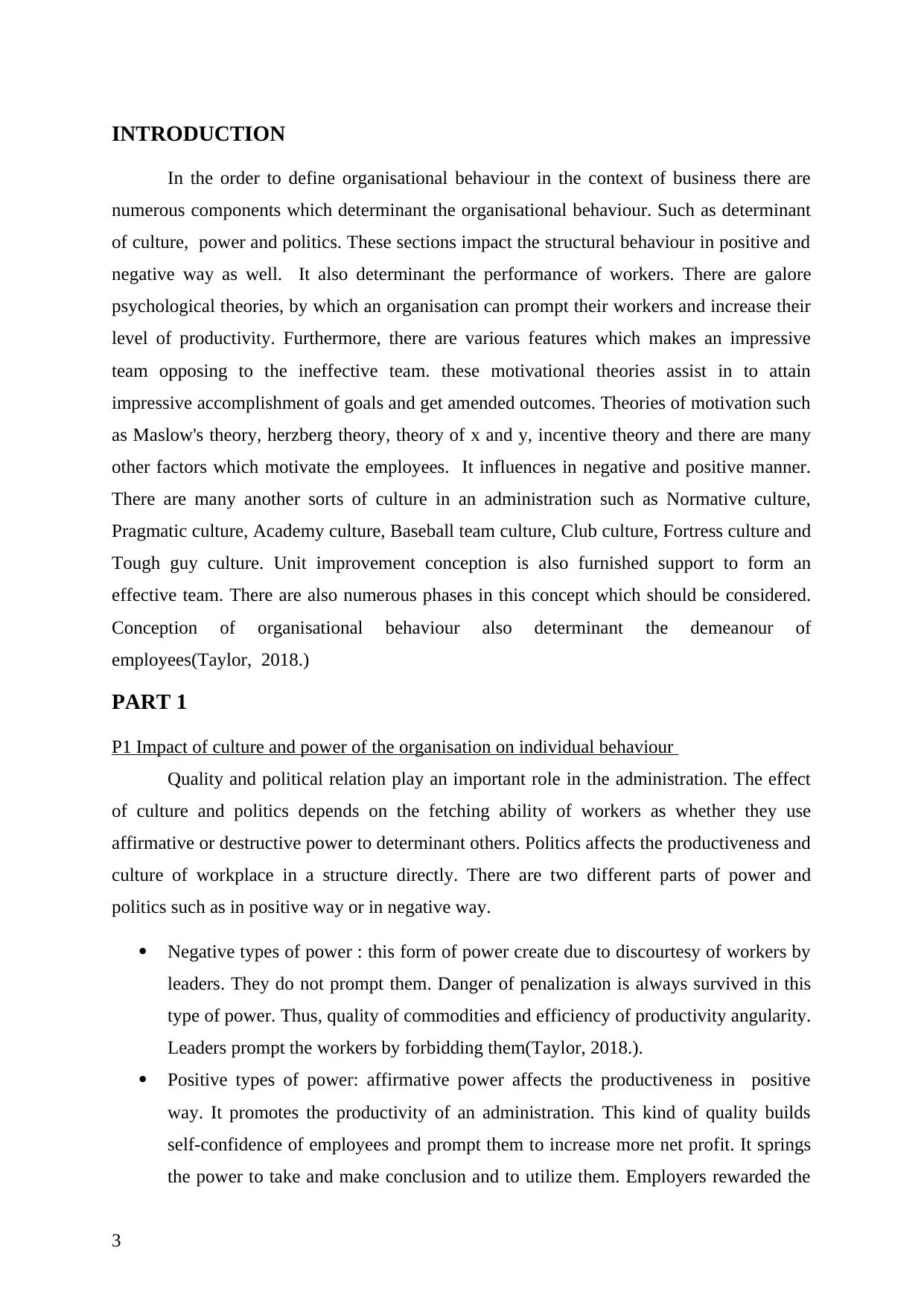
INTRODUCTION
In the order to define organisational behaviour in the context of business there are
numerous components which determinant the organisational behaviour. Such as determinant
of culture, power and politics. These sections impact the structural behaviour in positive and
negative way as well. It also determinant the performance of workers. There are galore
psychological theories, by which an organisation can prompt their workers and increase their
level of productivity. Furthermore, there are various features which makes an impressive
team opposing to the ineffective team. these motivational theories assist in to attain
impressive accomplishment of goals and get amended outcomes. Theories of motivation such
as Maslow's theory, herzberg theory, theory of x and y, incentive theory and there are many
other factors which motivate the employees. It influences in negative and positive manner.
There are many another sorts of culture in an administration such as Normative culture,
Pragmatic culture, Academy culture, Baseball team culture, Club culture, Fortress culture and
Tough guy culture. Unit improvement conception is also furnished support to form an
effective team. There are also numerous phases in this concept which should be considered.
Conception of organisational behaviour also determinant the demeanour of
employees(Taylor, 2018.)
PART 1
P1 Impact of culture and power of the organisation on individual behaviour
Quality and political relation play an important role in the administration. The effect
of culture and politics depends on the fetching ability of workers as whether they use
affirmative or destructive power to determinant others. Politics affects the productiveness and
culture of workplace in a structure directly. There are two different parts of power and
politics such as in positive way or in negative way.
Negative types of power : this form of power create due to discourtesy of workers by
leaders. They do not prompt them. Danger of penalization is always survived in this
type of power. Thus, quality of commodities and efficiency of productivity angularity.
Leaders prompt the workers by forbidding them(Taylor, 2018.).
Positive types of power: affirmative power affects the productiveness in positive
way. It promotes the productivity of an administration. This kind of quality builds
self-confidence of employees and prompt them to increase more net profit. It springs
the power to take and make conclusion and to utilize them. Employers rewarded the
3
In the order to define organisational behaviour in the context of business there are
numerous components which determinant the organisational behaviour. Such as determinant
of culture, power and politics. These sections impact the structural behaviour in positive and
negative way as well. It also determinant the performance of workers. There are galore
psychological theories, by which an organisation can prompt their workers and increase their
level of productivity. Furthermore, there are various features which makes an impressive
team opposing to the ineffective team. these motivational theories assist in to attain
impressive accomplishment of goals and get amended outcomes. Theories of motivation such
as Maslow's theory, herzberg theory, theory of x and y, incentive theory and there are many
other factors which motivate the employees. It influences in negative and positive manner.
There are many another sorts of culture in an administration such as Normative culture,
Pragmatic culture, Academy culture, Baseball team culture, Club culture, Fortress culture and
Tough guy culture. Unit improvement conception is also furnished support to form an
effective team. There are also numerous phases in this concept which should be considered.
Conception of organisational behaviour also determinant the demeanour of
employees(Taylor, 2018.)
PART 1
P1 Impact of culture and power of the organisation on individual behaviour
Quality and political relation play an important role in the administration. The effect
of culture and politics depends on the fetching ability of workers as whether they use
affirmative or destructive power to determinant others. Politics affects the productiveness and
culture of workplace in a structure directly. There are two different parts of power and
politics such as in positive way or in negative way.
Negative types of power : this form of power create due to discourtesy of workers by
leaders. They do not prompt them. Danger of penalization is always survived in this
type of power. Thus, quality of commodities and efficiency of productivity angularity.
Leaders prompt the workers by forbidding them(Taylor, 2018.).
Positive types of power: affirmative power affects the productiveness in positive
way. It promotes the productivity of an administration. This kind of quality builds
self-confidence of employees and prompt them to increase more net profit. It springs
the power to take and make conclusion and to utilize them. Employers rewarded the
3
⊘ This is a preview!⊘
Do you want full access?
Subscribe today to unlock all pages.

Trusted by 1+ million students worldwide
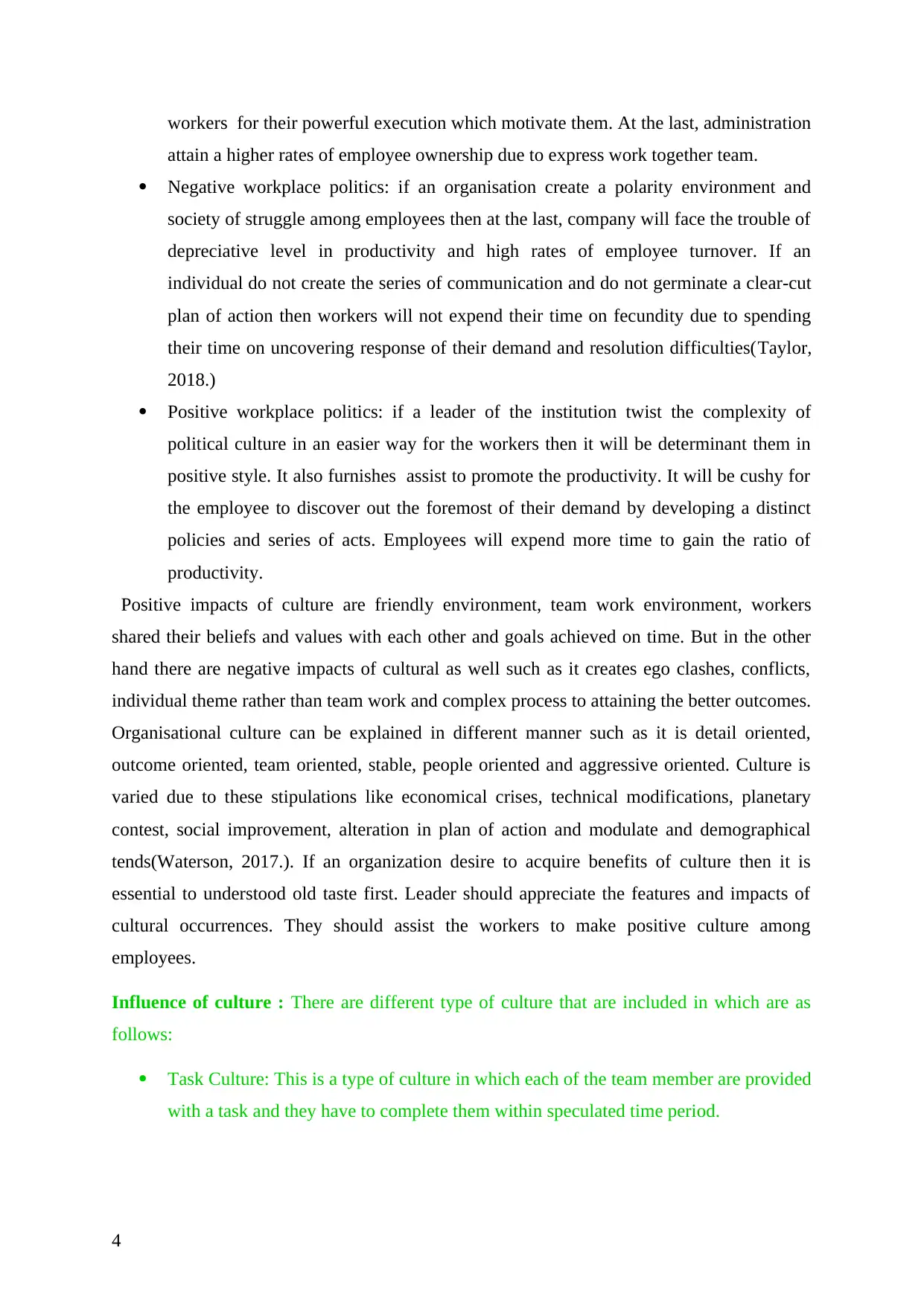
workers for their powerful execution which motivate them. At the last, administration
attain a higher rates of employee ownership due to express work together team.
Negative workplace politics: if an organisation create a polarity environment and
society of struggle among employees then at the last, company will face the trouble of
depreciative level in productivity and high rates of employee turnover. If an
individual do not create the series of communication and do not germinate a clear-cut
plan of action then workers will not expend their time on fecundity due to spending
their time on uncovering response of their demand and resolution difficulties(Taylor,
2018.)
Positive workplace politics: if a leader of the institution twist the complexity of
political culture in an easier way for the workers then it will be determinant them in
positive style. It also furnishes assist to promote the productivity. It will be cushy for
the employee to discover out the foremost of their demand by developing a distinct
policies and series of acts. Employees will expend more time to gain the ratio of
productivity.
Positive impacts of culture are friendly environment, team work environment, workers
shared their beliefs and values with each other and goals achieved on time. But in the other
hand there are negative impacts of cultural as well such as it creates ego clashes, conflicts,
individual theme rather than team work and complex process to attaining the better outcomes.
Organisational culture can be explained in different manner such as it is detail oriented,
outcome oriented, team oriented, stable, people oriented and aggressive oriented. Culture is
varied due to these stipulations like economical crises, technical modifications, planetary
contest, social improvement, alteration in plan of action and modulate and demographical
tends(Waterson, 2017.). If an organization desire to acquire benefits of culture then it is
essential to understood old taste first. Leader should appreciate the features and impacts of
cultural occurrences. They should assist the workers to make positive culture among
employees.
Influence of culture : There are different type of culture that are included in which are as
follows:
Task Culture: This is a type of culture in which each of the team member are provided
with a task and they have to complete them within speculated time period.
4
attain a higher rates of employee ownership due to express work together team.
Negative workplace politics: if an organisation create a polarity environment and
society of struggle among employees then at the last, company will face the trouble of
depreciative level in productivity and high rates of employee turnover. If an
individual do not create the series of communication and do not germinate a clear-cut
plan of action then workers will not expend their time on fecundity due to spending
their time on uncovering response of their demand and resolution difficulties(Taylor,
2018.)
Positive workplace politics: if a leader of the institution twist the complexity of
political culture in an easier way for the workers then it will be determinant them in
positive style. It also furnishes assist to promote the productivity. It will be cushy for
the employee to discover out the foremost of their demand by developing a distinct
policies and series of acts. Employees will expend more time to gain the ratio of
productivity.
Positive impacts of culture are friendly environment, team work environment, workers
shared their beliefs and values with each other and goals achieved on time. But in the other
hand there are negative impacts of cultural as well such as it creates ego clashes, conflicts,
individual theme rather than team work and complex process to attaining the better outcomes.
Organisational culture can be explained in different manner such as it is detail oriented,
outcome oriented, team oriented, stable, people oriented and aggressive oriented. Culture is
varied due to these stipulations like economical crises, technical modifications, planetary
contest, social improvement, alteration in plan of action and modulate and demographical
tends(Waterson, 2017.). If an organization desire to acquire benefits of culture then it is
essential to understood old taste first. Leader should appreciate the features and impacts of
cultural occurrences. They should assist the workers to make positive culture among
employees.
Influence of culture : There are different type of culture that are included in which are as
follows:
Task Culture: This is a type of culture in which each of the team member are provided
with a task and they have to complete them within speculated time period.
4
Paraphrase This Document
Need a fresh take? Get an instant paraphrase of this document with our AI Paraphraser
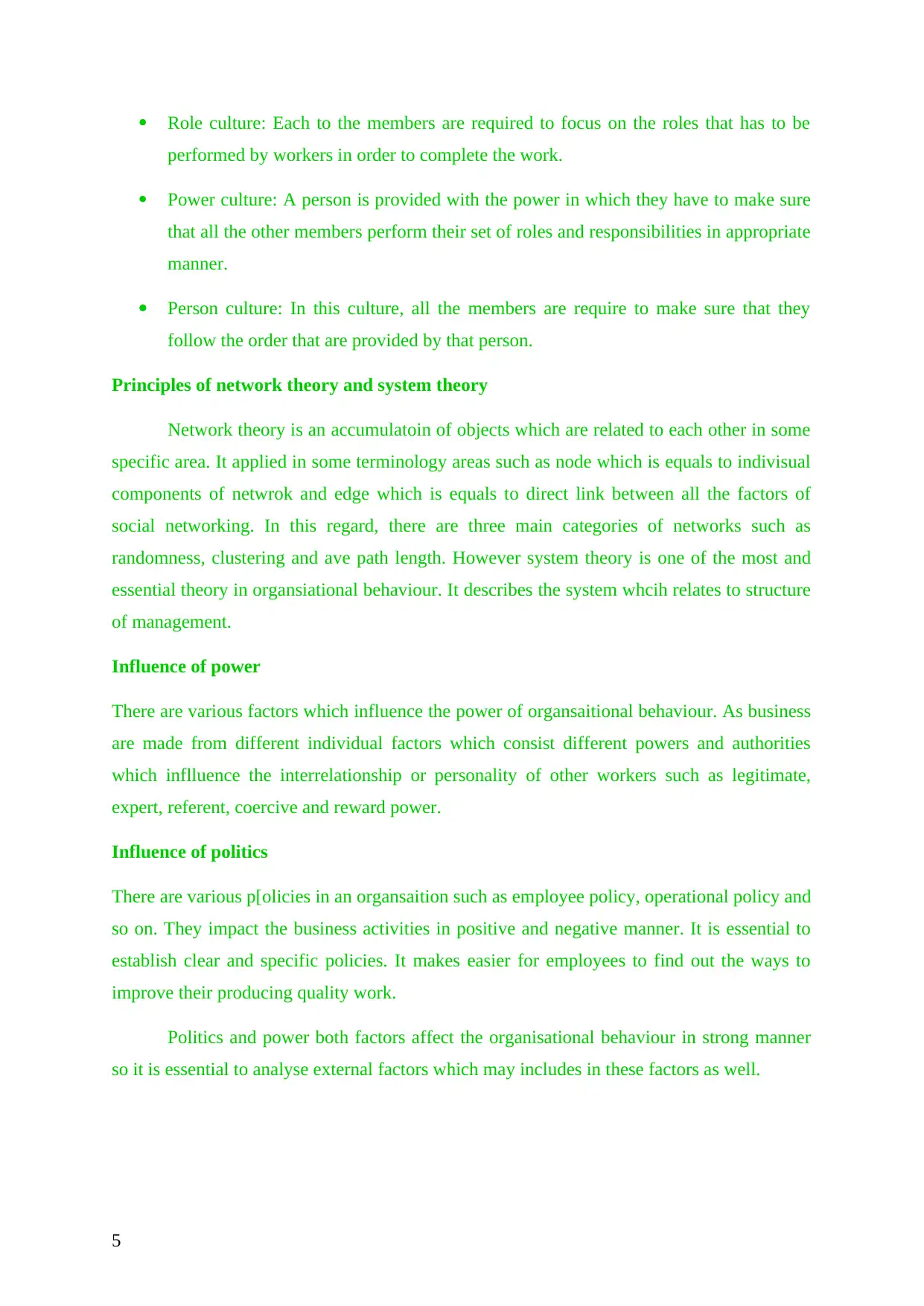
Role culture: Each to the members are required to focus on the roles that has to be
performed by workers in order to complete the work.
Power culture: A person is provided with the power in which they have to make sure
that all the other members perform their set of roles and responsibilities in appropriate
manner.
Person culture: In this culture, all the members are require to make sure that they
follow the order that are provided by that person.
Principles of network theory and system theory
Network theory is an accumulatoin of objects which are related to each other in some
specific area. It applied in some terminology areas such as node which is equals to indivisual
components of netwrok and edge which is equals to direct link between all the factors of
social networking. In this regard, there are three main categories of networks such as
randomness, clustering and ave path length. However system theory is one of the most and
essential theory in organsiational behaviour. It describes the system whcih relates to structure
of management.
Influence of power
There are various factors which influence the power of organsaitional behaviour. As business
are made from different individual factors which consist different powers and authorities
which inflluence the interrelationship or personality of other workers such as legitimate,
expert, referent, coercive and reward power.
Influence of politics
There are various p[olicies in an organsaition such as employee policy, operational policy and
so on. They impact the business activities in positive and negative manner. It is essential to
establish clear and specific policies. It makes easier for employees to find out the ways to
improve their producing quality work.
Politics and power both factors affect the organisational behaviour in strong manner
so it is essential to analyse external factors which may includes in these factors as well.
5
performed by workers in order to complete the work.
Power culture: A person is provided with the power in which they have to make sure
that all the other members perform their set of roles and responsibilities in appropriate
manner.
Person culture: In this culture, all the members are require to make sure that they
follow the order that are provided by that person.
Principles of network theory and system theory
Network theory is an accumulatoin of objects which are related to each other in some
specific area. It applied in some terminology areas such as node which is equals to indivisual
components of netwrok and edge which is equals to direct link between all the factors of
social networking. In this regard, there are three main categories of networks such as
randomness, clustering and ave path length. However system theory is one of the most and
essential theory in organsiational behaviour. It describes the system whcih relates to structure
of management.
Influence of power
There are various factors which influence the power of organsaitional behaviour. As business
are made from different individual factors which consist different powers and authorities
which inflluence the interrelationship or personality of other workers such as legitimate,
expert, referent, coercive and reward power.
Influence of politics
There are various p[olicies in an organsaition such as employee policy, operational policy and
so on. They impact the business activities in positive and negative manner. It is essential to
establish clear and specific policies. It makes easier for employees to find out the ways to
improve their producing quality work.
Politics and power both factors affect the organisational behaviour in strong manner
so it is essential to analyse external factors which may includes in these factors as well.
5
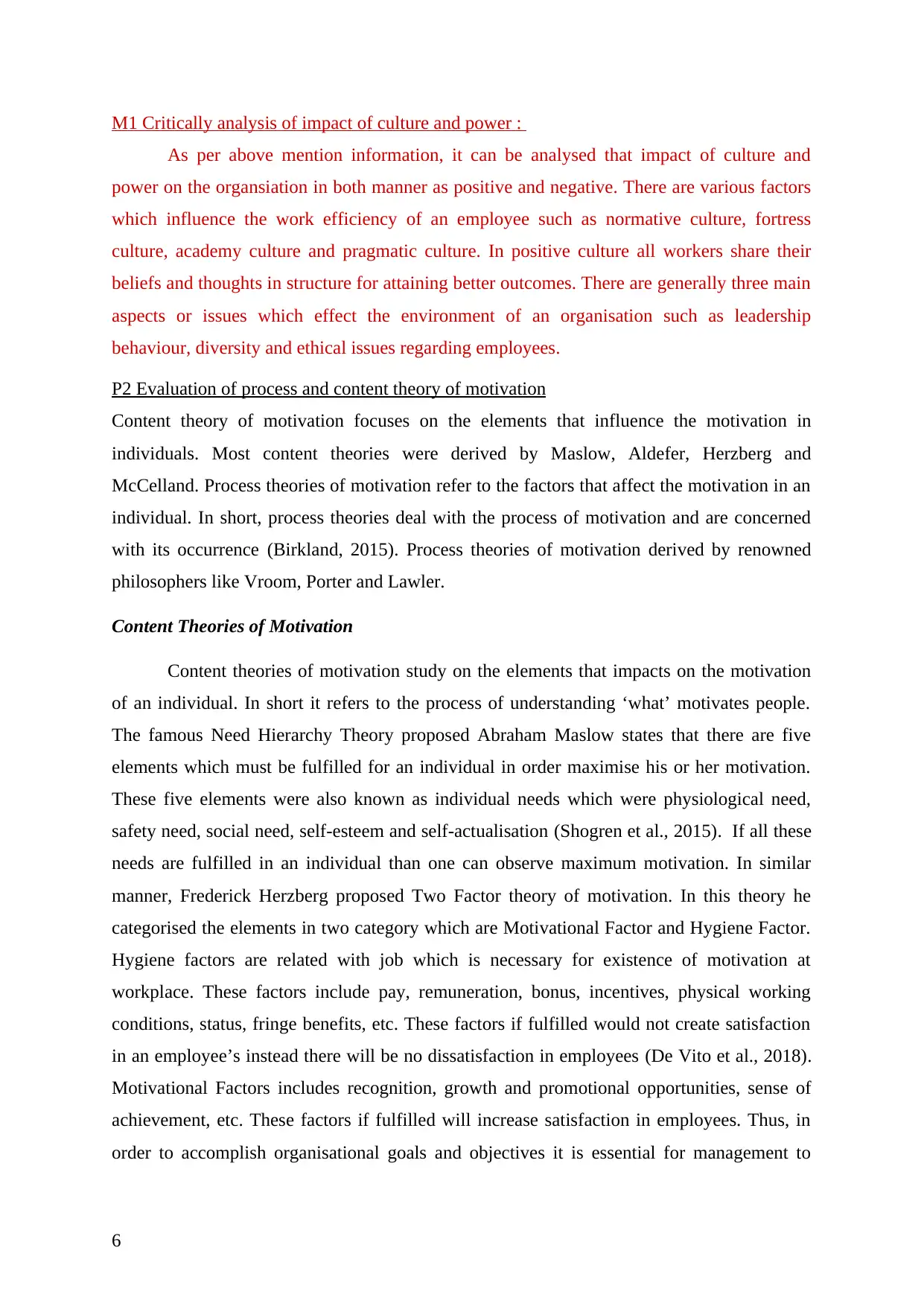
M1 Critically analysis of impact of culture and power :
As per above mention information, it can be analysed that impact of culture and
power on the organsiation in both manner as positive and negative. There are various factors
which influence the work efficiency of an employee such as normative culture, fortress
culture, academy culture and pragmatic culture. In positive culture all workers share their
beliefs and thoughts in structure for attaining better outcomes. There are generally three main
aspects or issues which effect the environment of an organisation such as leadership
behaviour, diversity and ethical issues regarding employees.
P2 Evaluation of process and content theory of motivation
Content theory of motivation focuses on the elements that influence the motivation in
individuals. Most content theories were derived by Maslow, Aldefer, Herzberg and
McCelland. Process theories of motivation refer to the factors that affect the motivation in an
individual. In short, process theories deal with the process of motivation and are concerned
with its occurrence (Birkland, 2015). Process theories of motivation derived by renowned
philosophers like Vroom, Porter and Lawler.
Content Theories of Motivation
Content theories of motivation study on the elements that impacts on the motivation
of an individual. In short it refers to the process of understanding ‘what’ motivates people.
The famous Need Hierarchy Theory proposed Abraham Maslow states that there are five
elements which must be fulfilled for an individual in order maximise his or her motivation.
These five elements were also known as individual needs which were physiological need,
safety need, social need, self-esteem and self-actualisation (Shogren et al., 2015). If all these
needs are fulfilled in an individual than one can observe maximum motivation. In similar
manner, Frederick Herzberg proposed Two Factor theory of motivation. In this theory he
categorised the elements in two category which are Motivational Factor and Hygiene Factor.
Hygiene factors are related with job which is necessary for existence of motivation at
workplace. These factors include pay, remuneration, bonus, incentives, physical working
conditions, status, fringe benefits, etc. These factors if fulfilled would not create satisfaction
in an employee’s instead there will be no dissatisfaction in employees (De Vito et al., 2018).
Motivational Factors includes recognition, growth and promotional opportunities, sense of
achievement, etc. These factors if fulfilled will increase satisfaction in employees. Thus, in
order to accomplish organisational goals and objectives it is essential for management to
6
As per above mention information, it can be analysed that impact of culture and
power on the organsiation in both manner as positive and negative. There are various factors
which influence the work efficiency of an employee such as normative culture, fortress
culture, academy culture and pragmatic culture. In positive culture all workers share their
beliefs and thoughts in structure for attaining better outcomes. There are generally three main
aspects or issues which effect the environment of an organisation such as leadership
behaviour, diversity and ethical issues regarding employees.
P2 Evaluation of process and content theory of motivation
Content theory of motivation focuses on the elements that influence the motivation in
individuals. Most content theories were derived by Maslow, Aldefer, Herzberg and
McCelland. Process theories of motivation refer to the factors that affect the motivation in an
individual. In short, process theories deal with the process of motivation and are concerned
with its occurrence (Birkland, 2015). Process theories of motivation derived by renowned
philosophers like Vroom, Porter and Lawler.
Content Theories of Motivation
Content theories of motivation study on the elements that impacts on the motivation
of an individual. In short it refers to the process of understanding ‘what’ motivates people.
The famous Need Hierarchy Theory proposed Abraham Maslow states that there are five
elements which must be fulfilled for an individual in order maximise his or her motivation.
These five elements were also known as individual needs which were physiological need,
safety need, social need, self-esteem and self-actualisation (Shogren et al., 2015). If all these
needs are fulfilled in an individual than one can observe maximum motivation. In similar
manner, Frederick Herzberg proposed Two Factor theory of motivation. In this theory he
categorised the elements in two category which are Motivational Factor and Hygiene Factor.
Hygiene factors are related with job which is necessary for existence of motivation at
workplace. These factors include pay, remuneration, bonus, incentives, physical working
conditions, status, fringe benefits, etc. These factors if fulfilled would not create satisfaction
in an employee’s instead there will be no dissatisfaction in employees (De Vito et al., 2018).
Motivational Factors includes recognition, growth and promotional opportunities, sense of
achievement, etc. These factors if fulfilled will increase satisfaction in employees. Thus, in
order to accomplish organisational goals and objectives it is essential for management to
6
⊘ This is a preview!⊘
Do you want full access?
Subscribe today to unlock all pages.

Trusted by 1+ million students worldwide
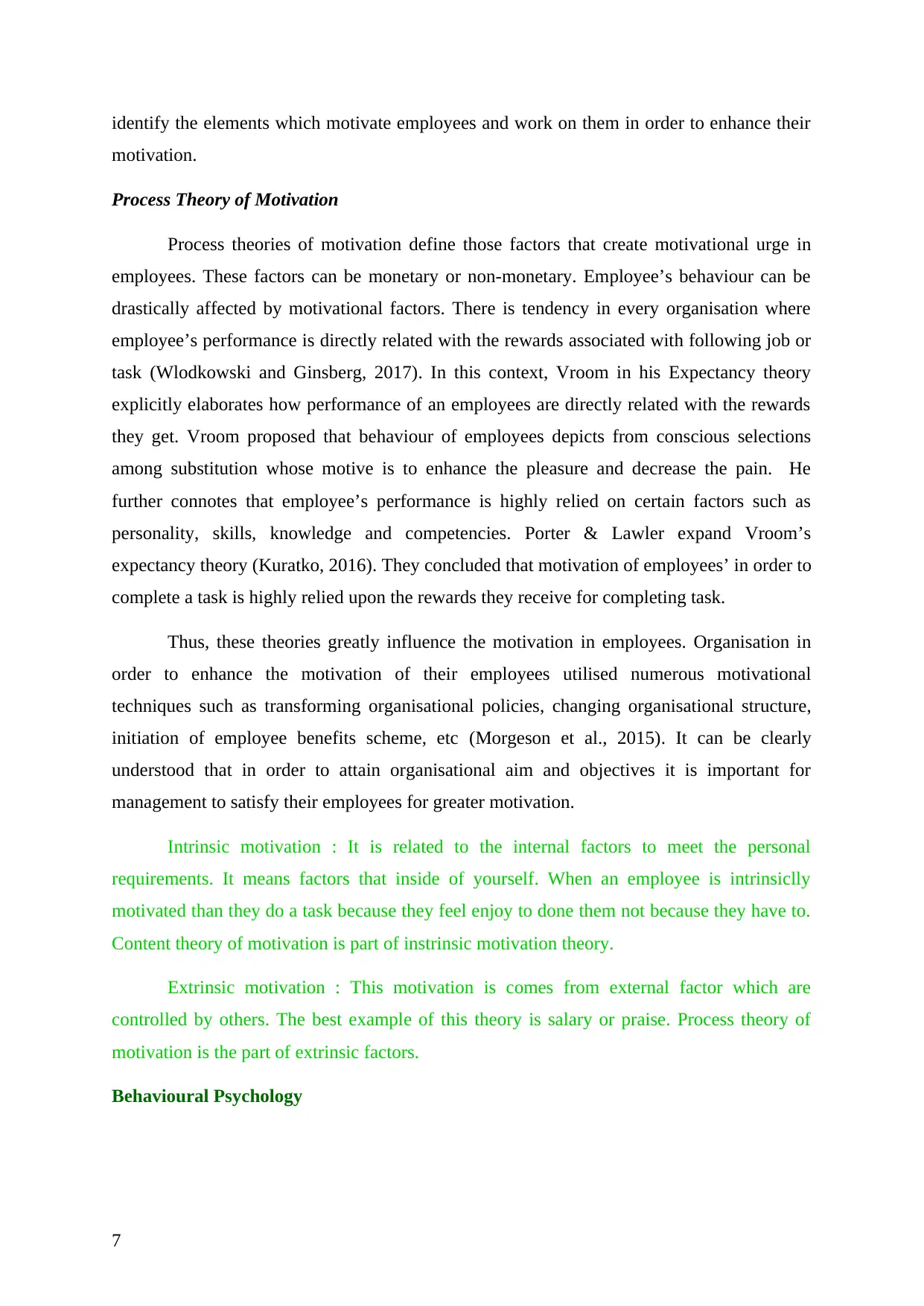
identify the elements which motivate employees and work on them in order to enhance their
motivation.
Process Theory of Motivation
Process theories of motivation define those factors that create motivational urge in
employees. These factors can be monetary or non-monetary. Employee’s behaviour can be
drastically affected by motivational factors. There is tendency in every organisation where
employee’s performance is directly related with the rewards associated with following job or
task (Wlodkowski and Ginsberg, 2017). In this context, Vroom in his Expectancy theory
explicitly elaborates how performance of an employees are directly related with the rewards
they get. Vroom proposed that behaviour of employees depicts from conscious selections
among substitution whose motive is to enhance the pleasure and decrease the pain. He
further connotes that employee’s performance is highly relied on certain factors such as
personality, skills, knowledge and competencies. Porter & Lawler expand Vroom’s
expectancy theory (Kuratko, 2016). They concluded that motivation of employees’ in order to
complete a task is highly relied upon the rewards they receive for completing task.
Thus, these theories greatly influence the motivation in employees. Organisation in
order to enhance the motivation of their employees utilised numerous motivational
techniques such as transforming organisational policies, changing organisational structure,
initiation of employee benefits scheme, etc (Morgeson et al., 2015). It can be clearly
understood that in order to attain organisational aim and objectives it is important for
management to satisfy their employees for greater motivation.
Intrinsic motivation : It is related to the internal factors to meet the personal
requirements. It means factors that inside of yourself. When an employee is intrinsiclly
motivated than they do a task because they feel enjoy to done them not because they have to.
Content theory of motivation is part of instrinsic motivation theory.
Extrinsic motivation : This motivation is comes from external factor which are
controlled by others. The best example of this theory is salary or praise. Process theory of
motivation is the part of extrinsic factors.
Behavioural Psychology
7
motivation.
Process Theory of Motivation
Process theories of motivation define those factors that create motivational urge in
employees. These factors can be monetary or non-monetary. Employee’s behaviour can be
drastically affected by motivational factors. There is tendency in every organisation where
employee’s performance is directly related with the rewards associated with following job or
task (Wlodkowski and Ginsberg, 2017). In this context, Vroom in his Expectancy theory
explicitly elaborates how performance of an employees are directly related with the rewards
they get. Vroom proposed that behaviour of employees depicts from conscious selections
among substitution whose motive is to enhance the pleasure and decrease the pain. He
further connotes that employee’s performance is highly relied on certain factors such as
personality, skills, knowledge and competencies. Porter & Lawler expand Vroom’s
expectancy theory (Kuratko, 2016). They concluded that motivation of employees’ in order to
complete a task is highly relied upon the rewards they receive for completing task.
Thus, these theories greatly influence the motivation in employees. Organisation in
order to enhance the motivation of their employees utilised numerous motivational
techniques such as transforming organisational policies, changing organisational structure,
initiation of employee benefits scheme, etc (Morgeson et al., 2015). It can be clearly
understood that in order to attain organisational aim and objectives it is important for
management to satisfy their employees for greater motivation.
Intrinsic motivation : It is related to the internal factors to meet the personal
requirements. It means factors that inside of yourself. When an employee is intrinsiclly
motivated than they do a task because they feel enjoy to done them not because they have to.
Content theory of motivation is part of instrinsic motivation theory.
Extrinsic motivation : This motivation is comes from external factor which are
controlled by others. The best example of this theory is salary or praise. Process theory of
motivation is the part of extrinsic factors.
Behavioural Psychology
7
Paraphrase This Document
Need a fresh take? Get an instant paraphrase of this document with our AI Paraphraser
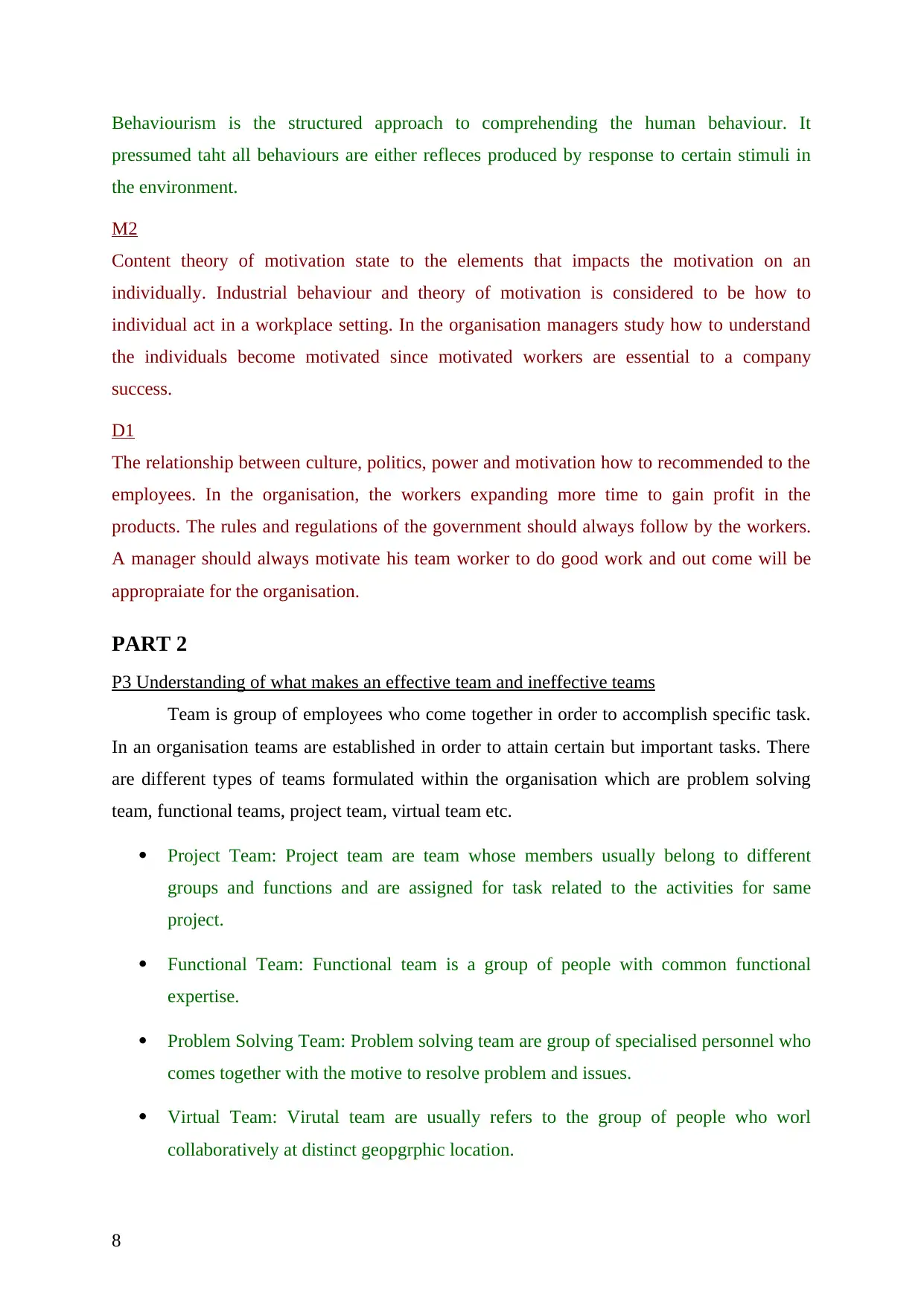
Behaviourism is the structured approach to comprehending the human behaviour. It
pressumed taht all behaviours are either refleces produced by response to certain stimuli in
the environment.
M2
Content theory of motivation state to the elements that impacts the motivation on an
individually. Industrial behaviour and theory of motivation is considered to be how to
individual act in a workplace setting. In the organisation managers study how to understand
the individuals become motivated since motivated workers are essential to a company
success.
D1
The relationship between culture, politics, power and motivation how to recommended to the
employees. In the organisation, the workers expanding more time to gain profit in the
products. The rules and regulations of the government should always follow by the workers.
A manager should always motivate his team worker to do good work and out come will be
appropraiate for the organisation.
PART 2
P3 Understanding of what makes an effective team and ineffective teams
Team is group of employees who come together in order to accomplish specific task.
In an organisation teams are established in order to attain certain but important tasks. There
are different types of teams formulated within the organisation which are problem solving
team, functional teams, project team, virtual team etc.
Project Team: Project team are team whose members usually belong to different
groups and functions and are assigned for task related to the activities for same
project.
Functional Team: Functional team is a group of people with common functional
expertise.
Problem Solving Team: Problem solving team are group of specialised personnel who
comes together with the motive to resolve problem and issues.
Virtual Team: Virutal team are usually refers to the group of people who worl
collaboratively at distinct geopgrphic location.
8
pressumed taht all behaviours are either refleces produced by response to certain stimuli in
the environment.
M2
Content theory of motivation state to the elements that impacts the motivation on an
individually. Industrial behaviour and theory of motivation is considered to be how to
individual act in a workplace setting. In the organisation managers study how to understand
the individuals become motivated since motivated workers are essential to a company
success.
D1
The relationship between culture, politics, power and motivation how to recommended to the
employees. In the organisation, the workers expanding more time to gain profit in the
products. The rules and regulations of the government should always follow by the workers.
A manager should always motivate his team worker to do good work and out come will be
appropraiate for the organisation.
PART 2
P3 Understanding of what makes an effective team and ineffective teams
Team is group of employees who come together in order to accomplish specific task.
In an organisation teams are established in order to attain certain but important tasks. There
are different types of teams formulated within the organisation which are problem solving
team, functional teams, project team, virtual team etc.
Project Team: Project team are team whose members usually belong to different
groups and functions and are assigned for task related to the activities for same
project.
Functional Team: Functional team is a group of people with common functional
expertise.
Problem Solving Team: Problem solving team are group of specialised personnel who
comes together with the motive to resolve problem and issues.
Virtual Team: Virutal team are usually refers to the group of people who worl
collaboratively at distinct geopgrphic location.
8
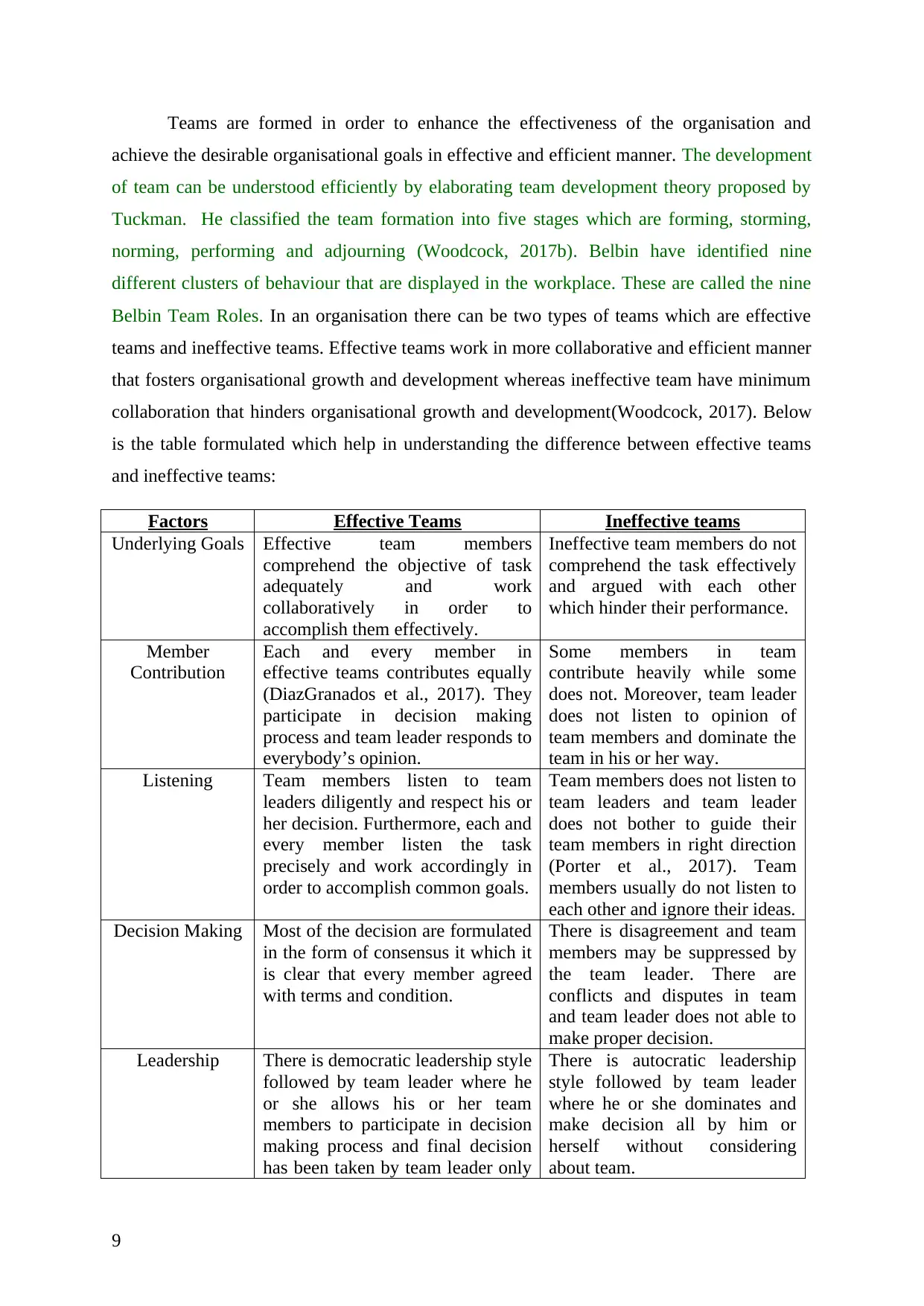
Teams are formed in order to enhance the effectiveness of the organisation and
achieve the desirable organisational goals in effective and efficient manner. The development
of team can be understood efficiently by elaborating team development theory proposed by
Tuckman. He classified the team formation into five stages which are forming, storming,
norming, performing and adjourning (Woodcock, 2017b). Belbin have identified nine
different clusters of behaviour that are displayed in the workplace. These are called the nine
Belbin Team Roles. In an organisation there can be two types of teams which are effective
teams and ineffective teams. Effective teams work in more collaborative and efficient manner
that fosters organisational growth and development whereas ineffective team have minimum
collaboration that hinders organisational growth and development(Woodcock, 2017). Below
is the table formulated which help in understanding the difference between effective teams
and ineffective teams:
Factors Effective Teams Ineffective teams
Underlying Goals Effective team members
comprehend the objective of task
adequately and work
collaboratively in order to
accomplish them effectively.
Ineffective team members do not
comprehend the task effectively
and argued with each other
which hinder their performance.
Member
Contribution
Each and every member in
effective teams contributes equally
(DiazGranados et al., 2017). They
participate in decision making
process and team leader responds to
everybody’s opinion.
Some members in team
contribute heavily while some
does not. Moreover, team leader
does not listen to opinion of
team members and dominate the
team in his or her way.
Listening Team members listen to team
leaders diligently and respect his or
her decision. Furthermore, each and
every member listen the task
precisely and work accordingly in
order to accomplish common goals.
Team members does not listen to
team leaders and team leader
does not bother to guide their
team members in right direction
(Porter et al., 2017). Team
members usually do not listen to
each other and ignore their ideas.
Decision Making Most of the decision are formulated
in the form of consensus it which it
is clear that every member agreed
with terms and condition.
There is disagreement and team
members may be suppressed by
the team leader. There are
conflicts and disputes in team
and team leader does not able to
make proper decision.
Leadership There is democratic leadership style
followed by team leader where he
or she allows his or her team
members to participate in decision
making process and final decision
has been taken by team leader only
There is autocratic leadership
style followed by team leader
where he or she dominates and
make decision all by him or
herself without considering
about team.
9
achieve the desirable organisational goals in effective and efficient manner. The development
of team can be understood efficiently by elaborating team development theory proposed by
Tuckman. He classified the team formation into five stages which are forming, storming,
norming, performing and adjourning (Woodcock, 2017b). Belbin have identified nine
different clusters of behaviour that are displayed in the workplace. These are called the nine
Belbin Team Roles. In an organisation there can be two types of teams which are effective
teams and ineffective teams. Effective teams work in more collaborative and efficient manner
that fosters organisational growth and development whereas ineffective team have minimum
collaboration that hinders organisational growth and development(Woodcock, 2017). Below
is the table formulated which help in understanding the difference between effective teams
and ineffective teams:
Factors Effective Teams Ineffective teams
Underlying Goals Effective team members
comprehend the objective of task
adequately and work
collaboratively in order to
accomplish them effectively.
Ineffective team members do not
comprehend the task effectively
and argued with each other
which hinder their performance.
Member
Contribution
Each and every member in
effective teams contributes equally
(DiazGranados et al., 2017). They
participate in decision making
process and team leader responds to
everybody’s opinion.
Some members in team
contribute heavily while some
does not. Moreover, team leader
does not listen to opinion of
team members and dominate the
team in his or her way.
Listening Team members listen to team
leaders diligently and respect his or
her decision. Furthermore, each and
every member listen the task
precisely and work accordingly in
order to accomplish common goals.
Team members does not listen to
team leaders and team leader
does not bother to guide their
team members in right direction
(Porter et al., 2017). Team
members usually do not listen to
each other and ignore their ideas.
Decision Making Most of the decision are formulated
in the form of consensus it which it
is clear that every member agreed
with terms and condition.
There is disagreement and team
members may be suppressed by
the team leader. There are
conflicts and disputes in team
and team leader does not able to
make proper decision.
Leadership There is democratic leadership style
followed by team leader where he
or she allows his or her team
members to participate in decision
making process and final decision
has been taken by team leader only
There is autocratic leadership
style followed by team leader
where he or she dominates and
make decision all by him or
herself without considering
about team.
9
⊘ This is a preview!⊘
Do you want full access?
Subscribe today to unlock all pages.

Trusted by 1+ million students worldwide
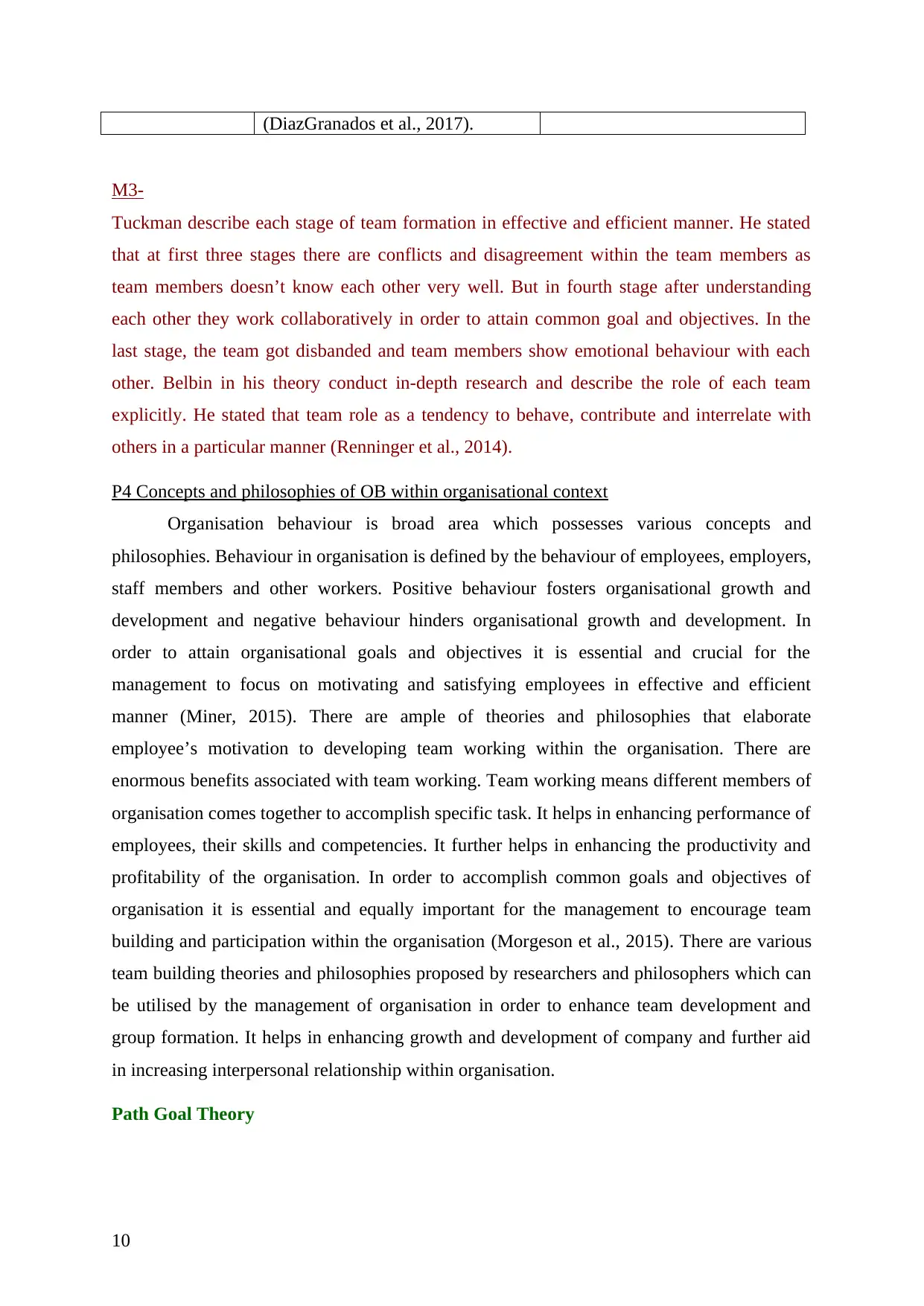
(DiazGranados et al., 2017).
M3-
Tuckman describe each stage of team formation in effective and efficient manner. He stated
that at first three stages there are conflicts and disagreement within the team members as
team members doesn’t know each other very well. But in fourth stage after understanding
each other they work collaboratively in order to attain common goal and objectives. In the
last stage, the team got disbanded and team members show emotional behaviour with each
other. Belbin in his theory conduct in-depth research and describe the role of each team
explicitly. He stated that team role as a tendency to behave, contribute and interrelate with
others in a particular manner (Renninger et al., 2014).
P4 Concepts and philosophies of OB within organisational context
Organisation behaviour is broad area which possesses various concepts and
philosophies. Behaviour in organisation is defined by the behaviour of employees, employers,
staff members and other workers. Positive behaviour fosters organisational growth and
development and negative behaviour hinders organisational growth and development. In
order to attain organisational goals and objectives it is essential and crucial for the
management to focus on motivating and satisfying employees in effective and efficient
manner (Miner, 2015). There are ample of theories and philosophies that elaborate
employee’s motivation to developing team working within the organisation. There are
enormous benefits associated with team working. Team working means different members of
organisation comes together to accomplish specific task. It helps in enhancing performance of
employees, their skills and competencies. It further helps in enhancing the productivity and
profitability of the organisation. In order to accomplish common goals and objectives of
organisation it is essential and equally important for the management to encourage team
building and participation within the organisation (Morgeson et al., 2015). There are various
team building theories and philosophies proposed by researchers and philosophers which can
be utilised by the management of organisation in order to enhance team development and
group formation. It helps in enhancing growth and development of company and further aid
in increasing interpersonal relationship within organisation.
Path Goal Theory
10
M3-
Tuckman describe each stage of team formation in effective and efficient manner. He stated
that at first three stages there are conflicts and disagreement within the team members as
team members doesn’t know each other very well. But in fourth stage after understanding
each other they work collaboratively in order to attain common goal and objectives. In the
last stage, the team got disbanded and team members show emotional behaviour with each
other. Belbin in his theory conduct in-depth research and describe the role of each team
explicitly. He stated that team role as a tendency to behave, contribute and interrelate with
others in a particular manner (Renninger et al., 2014).
P4 Concepts and philosophies of OB within organisational context
Organisation behaviour is broad area which possesses various concepts and
philosophies. Behaviour in organisation is defined by the behaviour of employees, employers,
staff members and other workers. Positive behaviour fosters organisational growth and
development and negative behaviour hinders organisational growth and development. In
order to attain organisational goals and objectives it is essential and crucial for the
management to focus on motivating and satisfying employees in effective and efficient
manner (Miner, 2015). There are ample of theories and philosophies that elaborate
employee’s motivation to developing team working within the organisation. There are
enormous benefits associated with team working. Team working means different members of
organisation comes together to accomplish specific task. It helps in enhancing performance of
employees, their skills and competencies. It further helps in enhancing the productivity and
profitability of the organisation. In order to accomplish common goals and objectives of
organisation it is essential and equally important for the management to encourage team
building and participation within the organisation (Morgeson et al., 2015). There are various
team building theories and philosophies proposed by researchers and philosophers which can
be utilised by the management of organisation in order to enhance team development and
group formation. It helps in enhancing growth and development of company and further aid
in increasing interpersonal relationship within organisation.
Path Goal Theory
10
Paraphrase This Document
Need a fresh take? Get an instant paraphrase of this document with our AI Paraphraser
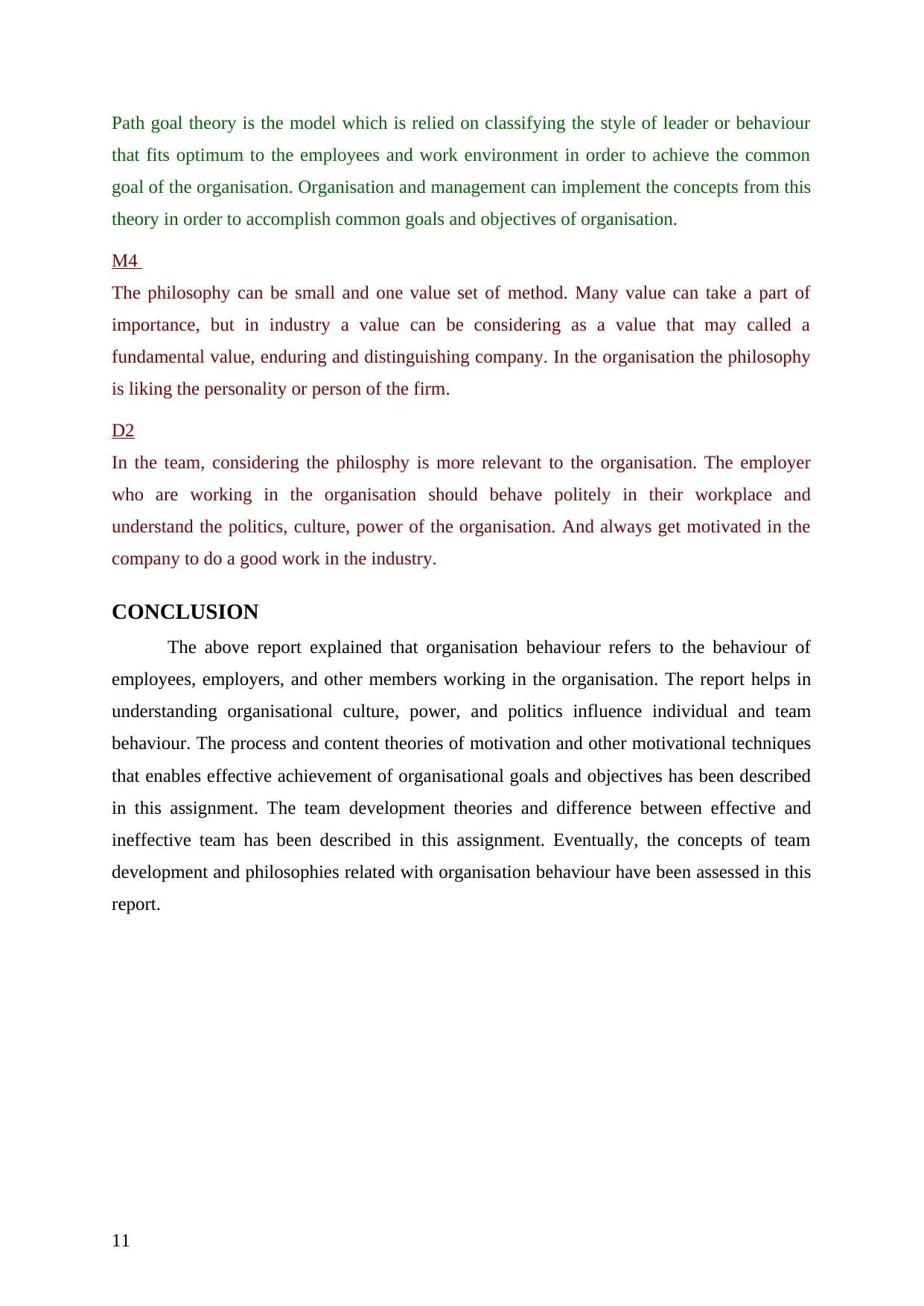
Path goal theory is the model which is relied on classifying the style of leader or behaviour
that fits optimum to the employees and work environment in order to achieve the common
goal of the organisation. Organisation and management can implement the concepts from this
theory in order to accomplish common goals and objectives of organisation.
M4
The philosophy can be small and one value set of method. Many value can take a part of
importance, but in industry a value can be considering as a value that may called a
fundamental value, enduring and distinguishing company. In the organisation the philosophy
is liking the personality or person of the firm.
D2
In the team, considering the philosphy is more relevant to the organisation. The employer
who are working in the organisation should behave politely in their workplace and
understand the politics, culture, power of the organisation. And always get motivated in the
company to do a good work in the industry.
CONCLUSION
The above report explained that organisation behaviour refers to the behaviour of
employees, employers, and other members working in the organisation. The report helps in
understanding organisational culture, power, and politics influence individual and team
behaviour. The process and content theories of motivation and other motivational techniques
that enables effective achievement of organisational goals and objectives has been described
in this assignment. The team development theories and difference between effective and
ineffective team has been described in this assignment. Eventually, the concepts of team
development and philosophies related with organisation behaviour have been assessed in this
report.
11
that fits optimum to the employees and work environment in order to achieve the common
goal of the organisation. Organisation and management can implement the concepts from this
theory in order to accomplish common goals and objectives of organisation.
M4
The philosophy can be small and one value set of method. Many value can take a part of
importance, but in industry a value can be considering as a value that may called a
fundamental value, enduring and distinguishing company. In the organisation the philosophy
is liking the personality or person of the firm.
D2
In the team, considering the philosphy is more relevant to the organisation. The employer
who are working in the organisation should behave politely in their workplace and
understand the politics, culture, power of the organisation. And always get motivated in the
company to do a good work in the industry.
CONCLUSION
The above report explained that organisation behaviour refers to the behaviour of
employees, employers, and other members working in the organisation. The report helps in
understanding organisational culture, power, and politics influence individual and team
behaviour. The process and content theories of motivation and other motivational techniques
that enables effective achievement of organisational goals and objectives has been described
in this assignment. The team development theories and difference between effective and
ineffective team has been described in this assignment. Eventually, the concepts of team
development and philosophies related with organisation behaviour have been assessed in this
report.
11
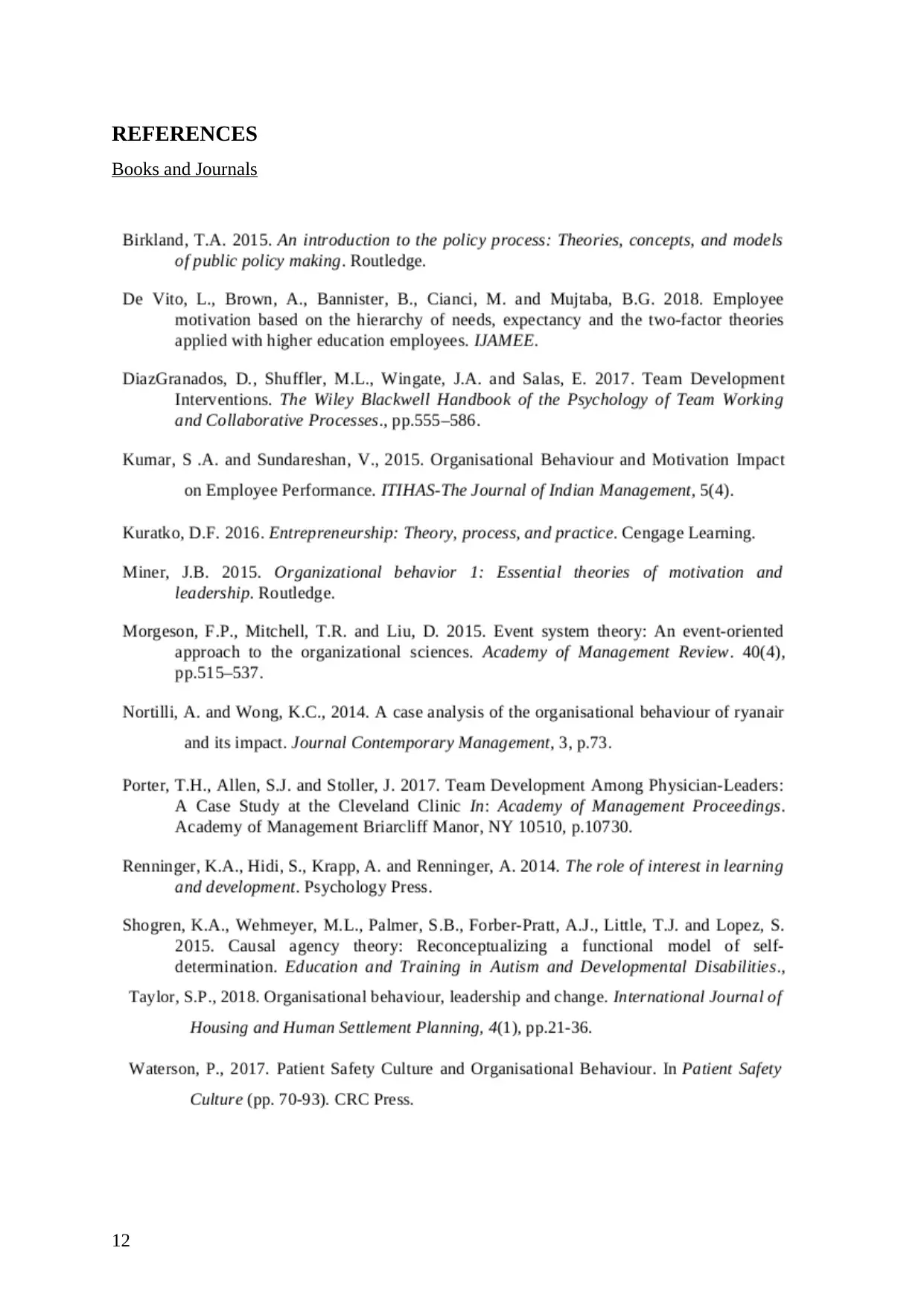
REFERENCES
Books and Journals
12
Books and Journals
12
⊘ This is a preview!⊘
Do you want full access?
Subscribe today to unlock all pages.

Trusted by 1+ million students worldwide
1 out of 13
Related Documents
Your All-in-One AI-Powered Toolkit for Academic Success.
+13062052269
info@desklib.com
Available 24*7 on WhatsApp / Email
![[object Object]](/_next/static/media/star-bottom.7253800d.svg)
Unlock your academic potential
Copyright © 2020–2025 A2Z Services. All Rights Reserved. Developed and managed by ZUCOL.





